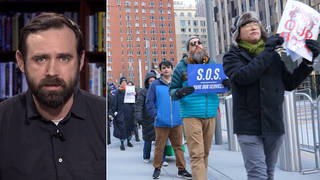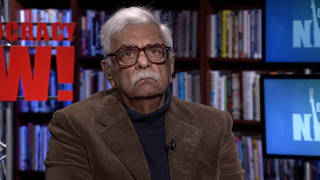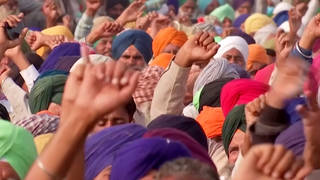
Related
Guests
- P. Sainathaward-winning Indian journalist and founder of the People’s Archive of Rural India, or PARI.
India just saw its biggest spike in coronavirus cases in 24 hours with 6,000 new reported infections, as an estimated 3 million seek shelter from a powerful cyclone and tens of thousands have no work or food. We go to Mumbai for an update from renowned journalist P. Sainath, founder of the People’s Archive of Rural India.
Transcript
AMY GOODMAN: This is Democracy Now!, democracynow.org, The Quarantine Report. I’m Amy Goodman, as we turn to India, which is starting to loosen its nationwide lockdown and just saw its biggest spike in coronavirus cases in 24 hours with 6,000 new reported infections. India, a country of 1.3 billion people, has reported more than 118,000 confirmed cases, more than 3,500 deaths. This comes as the most powerful cyclone to strike eastern India and Bangladesh in over a decade killed at least 82 people this week, forced an estimated 3 million people to leave their homes to seek shelter.
Meanwhile, a nationwide strike is underway today by many of India’s trade unions against the suspension of labor laws. Since the lockdown began in March, tens of thousands of migrant workers have been left jobless, face dangerous journeys to return home to smaller villages across India, most of them by foot. Hundreds have already lost their lives en route home. This is a migrant worker.
MIGRANT WORKER: [translated] Our employers threatened us when we went to ask for help. They said, “Do whatever you like. We don’t care.” Our families are really worried. They’ve been calling us over and over for days. We don’t have any food or water here. On the contrary, we are being beaten when we ask for it.
AMY GOODMAN: Well, for more, we go to Mumbai, India, where we’re joined by the award-winning Indian journalist P. Sainath. He’s the founder of People’s Archive of Rural India, or PARI, which focuses on rural India, where more than 833 million people live, speaking 780 living languages. But first, I want to play part of an interview by PARI with 11-year-old Paras Madikar. After the lockdown, his father lost his job as a driver, and the boy began selling vegetables to help his family make money.
PARAS MADIKAR: [translated] At 5:30 every morning, I go and get whatever vegetables I can find. And then I have to sell it. Those who want to buy, they buy it. Many people buy vegetables. Many don’t. I get very little time to study. I find little time in the morning. In the afternoon, after eating lunch, I again study for some time. I like going to school very much. My neck is hurting.
AMY GOODMAN: That’s an interview by PARI, the People’s Archive of Rural India.
For more, we’re joined by its founder, journalist P. Sainath. He’s also author of Everybody Loves a Good Drought: Stories from India’s Poorest Districts.
Welcome to Democracy Now! It’s so important to have you with us, Sainath, such an honor.
P. SAINATH: My pleasure. Thank you.
AMY GOODMAN: If you can talk — start off by talking about this boy, and even the founding of your archive, the kind of journalism you’re doing now? You were a well-known, major journalist, a mainstream journalist, but you felt that the people on the ground, the majority of India, were not being covered, their voices not heard.
P. SAINATH: Well, the average Indian national daily gives 0.67% of its front page for news of rural origin, where 69% of the population live. So, obviously — there is not a single newspaper, not a single national newspaper, not a single TV channel that has a national-level rural affairs editor or correspondent full-time, nor is there a full-time correspondent on the farming beat, nor is there a full-time correspondent on the labor beat. So, obviously, that gap is very huge. And we try filling it.
But I’d like to answer your thing about the boy, Paras Madikar. He was at school. He had never been a child laborer before. When they shut down the school, his father lost his job. His mother lost her job. Amy, according to the Centre for Monitoring Indian Economy, India lost 122 million jobs in the single month of April — OK? — at an unemployment rate of 27.1%, now down to 24%, 25% — 122 million jobs. And those were nonfarm-sector jobs, like his father, who was a watchman, a Chowkidar, a security guard in a building; like his mother, who was a cook in a canteen. All these jobs went. Ninety-one-point-three million of those jobs — mind you, the 122 million jobs is three times what you’ve lost in the United States. The 91.3 million were people who were small vendors, hawkers, tiny little stores, mom-and-pop stores, whatever. These are the ones that have got out. Many of those jobs are not coming back. Paras Madikar, that boy, he is one of those children who was thrown onto the streets to earn something, because his school shut down, and you don’t get the midday meal anymore. Right?
But it’s also very important for you to look at the large picture of what’s happening to these migrants. And it’s not just the migrants who are in trouble. You know, I think that COVID-19 has presented us — and, I think, much of the world — with a complete and total autopsy of the corpse of neoliberal policy of 28 years in India. Yeah. I think it’s done the same elsewhere for other countries. We now know how fragile large sections of the population are, after all the boasting about 8% growth and 9% growth and stuff. Yeah?
There are, I mean — and it also gives us a pretty good brain scan of neoliberal thinking. On last Sunday, the government of India passed an order. You saw that long march of the migrants, right? The government of India passed an order for a nationwide curfew between 7 p.m. and 7 a.m. You know what that does to the migrants on the highway, the millions of people on the highway? Yeah? It means that they can only now march hundreds, thousands, I mean, anywhere — they’re marching anywhere between 300 and 1,000 miles, Amy. And these people now can only march between 7 a.m. and 7 p.m. in temperatures ranging — you know, in temperatures ranging from 103 to 110 degrees Fahrenheit. That’s what the marchers are now — the people on the highways are now doing. Imagine that kind of thinking. Imagine the kind of — and that is neoliberal thinking. It makes rules to protect the beautiful people, and it has no part for the marginalized.
Look at how it’s thinking on hunger. We have not, in living memory, seen this kind of immediate, urgent hunger on the streets as has been happening here. This country is sitting on what the government says is 77 million tons of surplus food grain. I don’t call — I don’t use the word “surplus”; I think that’s a fraud. But it has 77 million tons of buffer stock. You know what it’s doing with that stock? It’s given permission — the government has issued permission last month to convert large portions of rice — I don’t know how many million tons — into ethanol, so that you can create large quantities of hand sanitizer. OK? You’re destroying food grain to create hand sanitizer, which also involves large-scale use of water. Yeah? And, of course, that ethanol will also go to blend petrol for fuel. I mean, this is the level of thinking when people are so hungry, when people are actually on the edge of starvation. We now know, after 28 years of this path of development, how narrow is the distance, how minimal the distance, between insecurity and hunger, and hunger and starvation.
The other thing they’ve done — oh, what’s the great thing that the states have done in response to this hunger and chaos and marches? We have reopened. You know what’s one of the first things to reopen, even before the so-called relaxation of the lockdown? Thousands and thousands of liquor shops. Maybe, you know, we’re being advised that you go on a liquid diet. I don’t know. But you have opened thousands of liquor shops. And the queues for those can be up to two kilometers, making a mockery of all the physical distancing stuff. But this is the way we are thinking. This is the way we are behaving. So, it’s really — I mean, you’ve lost 122 million jobs. People are terribly hungry. You have 77 million tons of grain piled up, and you’re thinking of creating ethanol from it. So, we really are — the migrants and others also are in a terrible, terrible state.
I also want to say that it’s not just the migrants. OK? See, we, in the People’s Archive of Rural India, we didn’t discover labor migrants on March 26th after the lockdown, like the rest of the corporate media did. We cover them 365 days a year. OK? We know who they are. We know them personally. As you said when you were introducing the subject, that — you know, you got a guy to say that “We are being beaten. We are running out of water. We are running out of food.” Amy, those — earlier, when migrants walked — they did walk long distances, even earlier, to go home — they would have tea stalls, little bus stands and stuff along the way, where they would stop, work for the evening, earn their way to the next 40, 50 kilometers, earn their way to the next 60 kilometers, to the next bus stand, where they would work in a tea stall. All those tea stalls and restaurants on the highway are now closed under the lockdown. So you’re going to have a lot of deaths from non-COVID ailments, old Indian friends like diarrhea, dehydration, hunger, exhaustion. These sort of things are happening.
You know, let me give you one example. One example, the case of young Jamlo, a 12-year-old girl, Indigenous person, who had gone with a party of people from her village — not her parents, but with others — to work in the chili fields, in the red chili fields of the neighboring state of Telangana. When the lockdown came and everyone was thrown off their jobs and their work, Jamlo walked 140 kilometers. A 12-year-old girl, she walked 140 kilometers in three days. I spend a hell of a lot of my time walking about the countryside. I’ve never done 140 kilometers in three days and nights. And she fell dead 60 kilometers from her home, in exhaustion and from muscle fatigue. OK? How many Jamlos have we now condemned the migrants to, when we bring in a curfew that says you can only, individuals — movement of individuals is strictly forbidden between 7 p.m. and 7 a.m.? How many more Jamlos are we pushing over the edge? The entire process of what’s going on is so utterly barbarous and, you know, shows what we have made of people.
Do you know — let me tell you a little aside about the 77 million tons of food. Do you know how much that is, Amy, in the kind of bags we pack it? If economists, like Jean Drèze, calculated 15 years ago — because we’ve had that surplus for more than 15, 20 years — that if the 77 million tons of food grain, if the sacks were laid in a row, you could reach the moon and back twice. It’s twice the distance to the moon. So you could go and come back, and you would still have some more grain left over. Yeah? You could easily, if you chose, meet the people’s hunger. You could do that. No, but the food distribution system under neoliberalism has not functioned — the stocks have not functioned to keep prices low. They are functioning to keep prices up.
AMY GOODMAN: So —
P. SAINATH: You have — yeah? Please.
AMY GOODMAN: So, talk about what this means right now for India today. And also, if you can talk about the — you can talk about the prejudice, the racism being expressed, trying to use the pandemic against Muslims in India and against Chinese Indians?
P. SAINATH: Yeah. Well, it’s not just Chinese Indians, but all people from the northeast who look Chinese to, you know, so-called mainstream India. But two things have been happening. I do understand that there has been racism, that there has been sectarian propaganda in many parts of the world, not the least in the United States, where you had the great “kung flu,” right?
But I do not believe anywhere else it’s at this level of communal, sectarian prejudice, where television channels don’t cover the coronavirus, but cover said suspected Islamic conspiracies that planted it here, because there was an event by a small fundamentalist group, a religious gathering in Delhi, which turned out to be a super spreader. But there were many other events by other religions and other groups, etc., but this was an identified one. And there are millions of people receiving WhatsApp messages in multiple languages telling them — you know, say, quoting a district judge — of course, a retired district judge, who can’t be traced — and there seem to be so many of them, because they seem to be in all languages — about how this whole thing was planned by Islamic groups to devastate India, Hindu India. OK? That’s one.
Second, fishermen in the east coast — and I want to make this point to your audience, Amy. Today we are listening about the migrants. There are millions of relatives of those migrants back in the villages they’re going. They are no less devastated. Yeah, the migrants are having it physically worse. But millions of livelihoods across the country were smashed by the way we organized and implemented our lockdown. Fishermen in the east coast of Andhra Pradesh, my home state, they are — you know, there is, anyway, a fishing ban between April 15 and June 14 to conserve fish stock, because that’s the breeding season for the fish, now, which means that the two weeks preceding that are the heaviest fishing period. OK? Those couldn’t happen because of the lockdown. And then, when the poor fishermen steal out at 2 a.m., 3 a.m. in the morning, at the risk of their lives, and bring back a few fish to eat, they’re not able to sell the rest. Either they sell it at one-fourth the price, or they’re told by customers, “Hey, we have seen on WhatsApp that these fish are from the east. They’re from China. And they’ve got — they’re carrying the coronavirus.” OK? I mean, it is funny, but it is so bloody widely accepted.
AMY GOODMAN: Sainath, we only have a minute, and I wanted to go to your comment that COVID-19 presents us with a complete and thorough autopsy of 28 years of neoliberalism in India. Your final comment?
P. SAINATH: Yeah. Well, one, as I said, it’s shown us what these policies on food — it’s like, for instance, for 35 years, we’ve all accepted — right? — that healthcare is something to be bought, sold, traded, and that health insurance equals health. This is neoliberalism. We have a country where the maximum amount of the health system is in private hands — I mean, where the maximum expenditure on health is from poor people, from their own pockets. That’s one, on the health.
On the education system, now what happens — all the rich schools and the colleges and private universities will switch to “online education.” What happens to the tens of millions of children? What happens to the tens of millions of children in government schools where you’re lucky to have a decent blackboard? What happens to that? So the education system is smashed. This was also the pushing of so-called affordable private schools. All this stuff came with neoliberalism. So we’ve been smashed on the hunger front, on the education front, on the health front.
And we now face a very serious crisis in the coming monsoon crop season, because after 25 years we promoted, like anything, cash crop for exports. If we repeat cash crops in the coming season, you’re going to have starvation, right? Because worldwide, as you know, income and consumption growth — income and consumption growth have crashed. Nobody is going to have huge orders of sugarcane and cotton. That’s not going to happen. Even the previous season’s stocks are piling up. I have been — we are desperate in People’s Archive of Rural India, appealing to farmers, “Grow only food crop, or you and your families are in very serious trouble.” So, that’s with farmers and laborers.
Each and every node of neoliberalism is now standing naked. Many of these things happened earlier, OK?
AMY GOODMAN: We have 20 seconds.
P. SAINATH: They were not brought on by the coronavirus. Yeah. They were not brought on by the coronavirus. They were brought on by conscious policy that this is how we should build a society. So, these things existed earlier, but now we can’t turn away from them. We can’t pretend we don’t see.
AMY GOODMAN: P. Sainath, we want to thank you so much for being with us, award-winning Indian journalist and founder of People’s Archive of Rural India. We thank you for being there. We’re going to link to your online website, and we hope to have you back very soon. The largest lockdown in world history is taking place right now in India.
This is Democracy Now! When we come back, Mike Davis. Stay with us.












Media Options